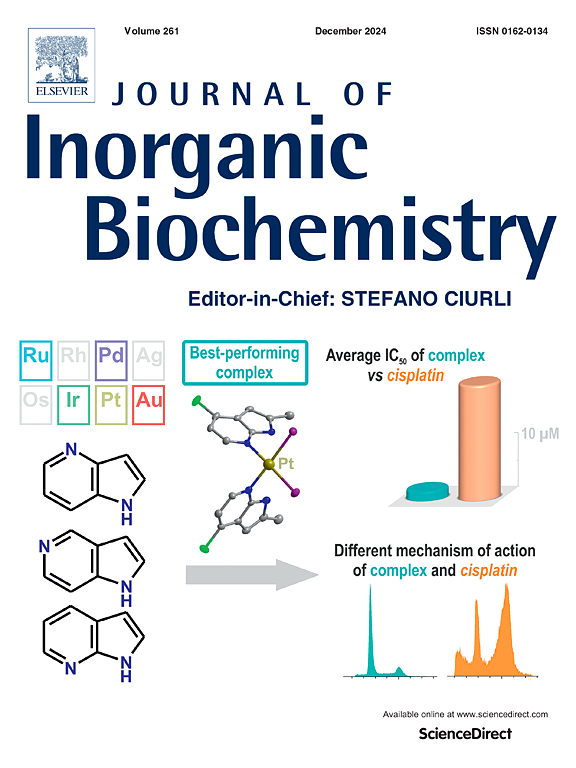白藜芦醇衍生物修饰Ru(II)配合物:合成、表征及体内体外抗癌研究
IF 3.8
2区 化学
Q2 BIOCHEMISTRY & MOLECULAR BIOLOGY
引用次数: 0
摘要
配体的多样化提供了更多的机会来调整Ru(II)配合物作为新型光敏剂的光物理性能和生物功能。本文设计并合成了一种以白藜芦醇衍生物氨基- res为配体的Ru(II)配合物。具有代表性的配合物Ru4在520nm光激发下表现出较强的抗癌活性。亲脂性和细胞积累实验表明,Ru4比Ru1-Ru3和[Ru(bpy)3]2+具有更高的LogPO/W值和细胞摄取。机制研究表明,Ru4具有抑制癌细胞迁移、侵袭和肿瘤发生的作用。Ru4的生物功能主要遗传自氨基- res配体。体内实验表明,Ru4能抑制肿瘤生长,无明显的系统毒性。本文章由计算机程序翻译,如有差异,请以英文原文为准。

Resveratrol derivative modified Ru(II) complexes: Synthesis, characterization, in vitro and in vivo anticancer study
The diversification of ligands provides more opportunities to adjust the photophysical performance as well as the bio-function of Ru(II) complexes as novel photosensitizers. Herein, a kind of Ru(II) complexes carrying resveratrol derivative, amino-Res, as ligand was designed and synthesized. The representative complex (named Ru4) showed potent anticancer activity under the trigger of 520 nm-light. Lipophilicity and cellular accumulation experiments indicated that Ru4 possessed higher LogPO/W value and cell up-take than Ru1-Ru3 and [Ru(bpy)3]2+. Mechanism study revealed that Ru4 could inhibit cancer cell migration, invasion and cancer stemness. The bio-function of Ru4 was mainly inherited from the amino-Res ligand. The in vivo study demonstrated that Ru4 could inhibit the tumor growth without significant system toxicity.
求助全文
通过发布文献求助,成功后即可免费获取论文全文。
去求助
来源期刊

Journal of Inorganic Biochemistry
生物-生化与分子生物学
CiteScore
7.00
自引率
10.30%
发文量
336
审稿时长
41 days
期刊介绍:
The Journal of Inorganic Biochemistry is an established international forum for research in all aspects of Biological Inorganic Chemistry. Original papers of a high scientific level are published in the form of Articles (full length papers), Short Communications, Focused Reviews and Bioinorganic Methods. Topics include: the chemistry, structure and function of metalloenzymes; the interaction of inorganic ions and molecules with proteins and nucleic acids; the synthesis and properties of coordination complexes of biological interest including both structural and functional model systems; the function of metal- containing systems in the regulation of gene expression; the role of metals in medicine; the application of spectroscopic methods to determine the structure of metallobiomolecules; the preparation and characterization of metal-based biomaterials; and related systems. The emphasis of the Journal is on the structure and mechanism of action of metallobiomolecules.
 求助内容:
求助内容: 应助结果提醒方式:
应助结果提醒方式:


